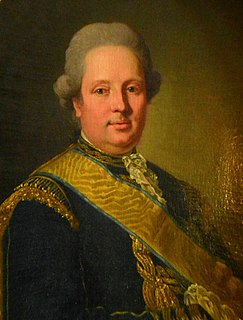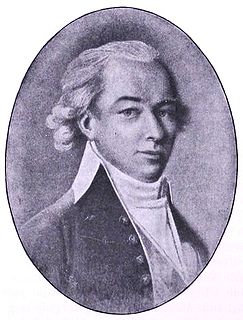
Olof Rudbeck the Younger or Olaus Rudbeckius d.y. was a Swedish explorer, scientist, botanist and ornithologist.

The Great Northern War was the war fought between a coalition of Denmark–Norway, Russia and Saxony-Poland on one side and Sweden on the other side from 1700 to 1721. It started by a coordinated attack on Sweden by the coalition in 1700, and ended 1721 with the conclusion of the Treaty of Nystad, and the Stockholm Treaties. As a result of the war, Russia supplanted Sweden as the dominant power on the shores of the Baltic Sea, becoming a major player in European politics.

Baron Klaus Fleming was a Finnish-born member of the Swedish nobility and admiral, who played an important role in Finnish and Swedish history during the rise of Sweden as a Great Power. He was a trustee of kings John III and Sigismund Vasa.

Adolf Arnold Louis Palander af Vega was a Swedish naval officer, mostly remembered as the captain on Adolf Erik Nordenskiöld's Vega expedition, the first successful attempt to navigate the Northeast Passage.

Claes Johansson Uggla was a Swedish military officer of the 17th century, who served in both the army and the navy, reaching the rank of Admiral before he was killed in action during the naval Battle of Öland.

Olof Rudolf Cederström was a Swedish naval commander. Cederström enlisted in the Swedish admiralty in 1779. As captain, he conducted a raid against Rogervik, and distinguished himself in 1790 at the naval Battle of Reval and the Battle of Viborg Bay. During the following years he led ships against English privateers in the North Sea. He was sent in 1801 to fight alongside the United States Navy in the Mediterranean during the First Barbary War. In 1808 his ships were sent to blockade Gotland in order to repel the Russian invaders. His last military action was against Denmark and France in 1813, when he helped Swedish forces capture Vorpommern. In 1815 he was appointed a minister, but returned to the navy in 1818, and resigned in 1828.
The Lord High Admiral or Admiral of the Realm was a prominent and influential office in Sweden, from c. 1571 until 1676, excluding periods when the office was out of use. The office holder was a member of the Swedish Privy Council and the head of the navy and Admiralty of Sweden. From 1634, the Lord High Admiral was one of five Great Officers of the Realm.

Olof Arenius was a Swedish portrait painter.

Henrik af Trolle was a Swedish naval officer and commander of the Swedish Archipelago fleet. He was ennobled in 1772. He is considered to be one of the foremost administrators and developers of the Swedish Navy throughout the ages.
Pros Mund was a Danish admiral during the Thirty Years War.

Erik Gabrielsson Emporagrius was a Swedish professor and bishop.

The Battle of Gothenburg was a Danish attempt to destroy the Swedish squadron in Gothenburg, which was led by Olof Strömstierna. The Danes were led by the famous Peter Tordenskjold. The Swedish land defence was led by Fredrik of Hessen, and it consisted of the land batteries Billingen and Rya Nabbe with 12 guns each, and the Älvsborg fortress, who had 400 soldiers with 90 guns.

Johan Fredrik Martin was a Swedish painter and engraver of the eighteenth century. He worked in a variety of media, especially stipple, contour etching and aquatint.

The Attack on Marstrand was a successful Dano-Norwegian siege of the Swedish town of Marstrand and Carlsten fortress which took place between July 10 and July 16, 1719 during the end of the Great Northern War.

Baron Salomon Maurits von Rajalin was a Swedish Navy admiral and civil servant.
Maerten Thijssen, dead 1657, was a Dutch admiral that entered into Swedish service, becoming a Swedish admiral and a Swedish nobleman under the name Mårten Anckarhielm. He played an important role at the Battle of Fehmarn 1644.

Wingård, is a Danish-Swedish family of German origin from Stuttgart, Duchy of Württemberg, Holy Roman Empire. Hans Wyngarthener emigrated and settled the first printing press in Denmark in the 16th century. His great-grandson Anders Nielsen Wingaard relocated to Sweden as the fourth Lutheran Vicar in Krokstad parish, Diocese of Gothenburg, in Bohuslän. His great-great-great-grandson Carl Fredrik was ennobled af Wingård in 1799 on the merits of his father during the reign of King Gustav IV Adolf of Sweden.

Magnus (Måns) Rosén von RosensteinnéAurivillius was a Swedish Navy rear admiral. After having served in the Fleet of the Army, Rosenstein joined the Royal Navy in the American Revolutionary War against the French. He then joined the French Navy and took part in the Battle of the Saintes where he was taken prisoner by his former commander Admiral Sir Peter Parker and was imprisoned in England. He was quit immediately released, returned to Sweden and would later distinguished himself in the Battle of Svensksund. Rosenstein retired with the rank of rear admiral in the Swedish Navy in 1797 and died in his hometown of Uppsala in 1801.

The battles at Göta älv were a series of battles and sieges which took place in and around the Gothenburg area between 1717 and 1719, between the Swedish Empire and Denmark-Norway, during the Great Northern War.
























